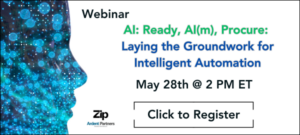Did you miss Ardent Partners’ recent webinar, Evolution of AI in Procurement: The Agentic Age, that shed light on how artificial Intelligence (AI) has come a long way — from basic rule-based systems to today’s advanced models that can learn, reason, solve problems, and even create.
The session featured industry experts from Ardent Partners, as well as Fairmarkit’s CEO, Kevin Frechette, and Coca-Cola Europacific Partners’ Director – Procurement CoE, Anthony Breach, who explored artificial intelligence in procurement and its evolution from generative AI to Agentic AI that actively pursue objectives and take meaningful action in the real world.
In this four-part series, we feature articles based on the webcast discussion as well as this link to the full event.
Today, in Part Four, we explore how the procurement landscape is undergoing significant transformation as AI and agentic systems evolve from experimental tools to embedded digital coworkers, gradually delivering measurable efficiency and business value. Rather than replacing human judgment, these technologies augment workflows, particularly in areas like tail spend, risk management, and operational sourcing, by automating routine tasks and surfacing insights for better decision-making. This shift is marked by continuous collaboration, iterative improvement, and a strong focus on personalization, with organizations like Fairmarkit leading the way toward a more intelligent, adaptive, and human-centric future in procurement.
Rethinking Procurement: How AI, Agentic Networks, and Human Collaboration Are Shaping the Future
The evolution of procurement is rapidly accelerating as artificial intelligence (AI) and agentic systems reshape the landscape of digital workflows and organizational decision-making. As businesses navigate the expanding capabilities of these technologies, the conversation is shifting from “if” to “how” they can effectively integrate them to drive real, scalable business value.
At the heart of this evolution lies the question: Have we truly reached the point where the deployment of AI agents is delivering the desired business outcomes? Right now, many organizations seem to be riding the “hype cycle” — a familiar pattern of inflated expectations followed by a more sober phase of practical integration. However, with the increasing maturity of AI-driven solutions, especially agentic systems (self-directed digital entities that can act on behalf of humans), businesses are beginning to see how this technology could reshape not only individual workflows but entire networks of collaboration.
The Shift From Traditional to Agentic AI
A pivotal shift is underway, as organizations move from traditional systems integration, where software platforms interact through rigid APIs, toward agentic networks where AI-powered agents handle the interactions. Imagine multiple platforms, each with its own digital workforce of agents, coordinating complex tasks across lines of business like procurement, finance, and HR without the need for human intervention at every step. This raises new challenges, including defining the ground rules for how these autonomous agents will communicate across platforms — a fascinating area for future exploration.
At Fairmarkit, this thinking is already being applied in practical ways, especially in tail spend management — the lower-value, lower-complexity purchases that traditionally drain significant time and resources. The goal is full autonomy for these transactions: from recognizing demand and automatically creating sourcing events, to recommending suppliers, soliciting bids, and awarding contracts — all with zero human touch. Some organizations have already reached a point where they’re running tens of thousands of such events annually, fully autonomous and entirely seamless.
Of course, not every procurement scenario lends itself to complete automation. For tactical spend, where purchases are more nuanced, human oversight remains essential. This isn’t necessarily tied to a particular category or spend threshold, but rather the nature of the specific sourcing event. AI in this scenario serves to assist, not replace, the human decision-making process — surfacing the right information at the right time, much like an experienced surgical assistant — enabling procurement professionals to focus on value-driven choices rather than mechanical tasks.
When moving further up the complexity curve into strategic spend, human involvement becomes even more critical. Here, AI acts as an augmentation layer, generating drafts (such as SOWs) or analyzing the outcomes of complex sourcing events, but still deferring to human judgment for final decisions.
This step-by-step progression of AI and agent adoption mirrors the broader mindset shift in the industry. The focus is on continuous, iterative improvements rather than a single, transformational moment where AI suddenly replaces everything. The roadmap Fairmarkit follows shows this clearly: from initial AI feature development to the embrace of generative AI (GenAI), and now into the deployment of agentic systems. Each phase builds on the last, reinforcing a philosophy of learning, launching, iterating, and improving — all in real time.
Embedded AI and Agents
One key realization along this journey is the difference between AI features that create temporary excitement versus those that drive sustained business value. The focus is increasingly on embedding AI and agents into everyday workflows as persistent collaborators (digital coworkers) rather than standalone, one-time-use tools.
This development path also echoes how AI is being adopted across procurement teams more broadly. It’s not about flipping a switch and moving from manual to fully autonomous overnight. Instead, AI gradually carves out 10%–15% efficiency gains across tasks, layers in intelligence, and expands autonomy step by step. The exciting part is that the roadmap isn’t fixed; the industry expects more growth, with “Agent 2.0” innovations likely to emerge in the next few years, reshaping what’s possible.
Another important ingredient in this evolution is collaboration within organizations and between vendors and clients. A great example of this is Fairmarkit’s ongoing “jam sessions,” a recurring workshop that brings together customers and partners in an informal, exploratory setting. Rather than a rigid, outcome-driven meeting, these sessions encourage free thinking about potential AI and agentic use cases, fostering a shared learning journey.
One of the major focus areas emerging from these sessions is operational sourcing: breaking down the sourcing process to identify which tasks agents could handle, from data validation and supplier communication to bid analysis and summarization. What’s striking is that the solution isn’t one single “super-agent” but rather a coordinated network of specialized agents, each contributing to different steps of the process. When scaled, this could support tens of thousands of events with a level of efficiency that humans alone could never achieve.
Another area ripe for agentic transformation is contracting. Today, procurement teams deal with everything from complex, global contracts to more routine, tactical agreements — all of which demand time-consuming human effort. Agents can assist by integrating data from spend history, supplier performance, and market conditions to proactively suggest renewals, renegotiations, or consolidations. This enables procurement professionals to spend less time on administrative tasks and more time on strategic decisions.
Risk management is another challenge that agentic systems are well suited to tackle, particularly as regulatory complexity grows. Most organizations rely on humans to manually monitor compliance and assess supplier risk, often missing critical issues due to sheer volume and limited resources. Agents can continuously assess risk, flag relevant changes, and even execute follow-up actions, transforming risk management from a reactive burden into a proactive, intelligent process.
Finally, one of the most transformative — and sometimes underestimated — aspects of this shift is user engagement. As AI systems evolve, the way humans interact with them is set to change dramatically. The future will likely move away from logging into traditional procurement systems and toward multi-modal interactions, such as voice, text, images, and even video, meeting users where they are. Personalization will be key, ensuring the experience feels natural and helpful rather than forced or generic.
Ultimately, the goal is to make AI and agents integral to the work experience, not just tools that sit on the side. When systems understand individual needs, workflows, and communication preferences, adoption will rise — and so will the value these technologies deliver.
Looking ahead, the procurement landscape will likely be defined not just by the tools organizations adopt, but by how flexibly and thoughtfully they evolve with them. AI and agents aren’t here to replace humans, but to empower them to focus on higher-value thinking, strategy, and creativity — while machines handle the heavy lifting of routine, repeatable tasks. The organizations that embrace this partnership model will be the ones best positioned for success in the years to come.


